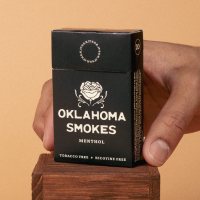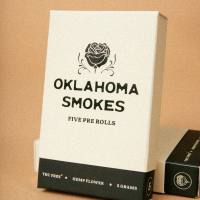While cigarettes had once been advertised as “cool” or upper class to smoke, the terrifying health risks and addiction associated with nicotine and tobacco have continued to come forth.
As tobacco-free products have found their way onto the market in an attempt to encourage smokers to pull away from nicotine, it has been met by a wall of myths and claims. It’s time to dig into smokeless tobacco.
With so many claims surrounding tobacco-free smoking options, it’s hard to tell what’s myth, and what's truth.
Common Myths
Regardless if someone is pro-smoking, or anti-smoking, information has been inflated or simply made-up over the years. With false statements being spread as fact, it’s hard to distinguish myth from fact.
MYTH: Tobacco Free Cigarettes Are Just As Bad As Regular Cigarettes
To consider whether or not tobacco-free options are “just as bad,” it’s important to understand what is actually bad in cigarettes in the first place.
While many consumers think that nicotine is the primary issue with cigarettes, it’s only part of the issue. Nicotine is a highly addictive chemical that keeps you coming back for more. Nicotine attaches to your brain's receptors and releases dopamine, a feel-good brain chemical responsible for forming habits.
While nicotine keeps bringing you back for more, a mix of 3000 other toxins found in cigarettes cause the most severe health risks. This includes traces of metals such as lead, hydrogen cyanide, carbon monoxide, ammonia, and much more.
Tar refers to the sticky brown chemical left behind when cigarettes burn. This is a mix of different chemicals, which release large particles when smoked. Tar is toxic, and over time, finds its way into smokers’ lungs.
The actual smoke itself causes damage within the mouth, throat, and lungs because of all the toxins it carries in it. Inhaling this toxin-filled smoke has the ability to cause severe irritation, and could lead to health issues such as asthma or shortness of breath.
Tobacco-free smoking products aren’t going to be perfect. They come with risk, but a significantly reduced risk compared to the effects of cigarettes. Tobacco-free smoke products are intended to help a smoker quit, and to be used as a tool on the journey to becoming smoke-free. While they may have mild health risks, the reduced risk paired with the ability for a user to pull themselves away from addictive nicotine is vital to becoming smoke-free.

MYTH: Other Forms of Tobacco Aren’t As Harmful As Cigarettes
This idea is often followed by the idea that it’s the other chemicals within the cigarettes that are harmful, and not the tobacco.
Each form of tobacco use is accompanied by increased risk of severe health conditions. The damage found with using tobacco also goes further than the tobacco itself.
Any form of tobacco being smoked will not only have the risks of tobacco and nicotine, but will also have added risks associated with tobacco smoke inhalation such as difficulty breathing, a weakened immune system, loss of smell, and damage to the mouth and throat.
Cigars and briars (tobacco pipes) produce a thick smoke that are meant to be kept in the mouth. The nicotine then absorbs through the mouth and into the blood. When smoking these forms of tobacco, major damage can occur to the mouth, nose, and throat. Smoke is still inhaled, maintaining the risk for lung cancer and other forms of damage, especially right at the top of the throat and the mouth where many smokers like to linger cigar and pipe smoke.
While chew and snuff aren’t smoked, they create a different set of health risks. These products are placed between the lip and gums, allowing the nicotine to be absorbed into the body. This constant contact and exposure in such a small area of the body daily increases the risk of mouth, gum, and throat damage, particularly mouth cancer.
MYTH: Hemp Will Cause Addiction Because It’s Cannabis
It’s important to separate marijuana and hemp. While it’s true that hemp originates from the Cannabis sativa plant, hemp is grown to have nearly non-existent traces of THC.
THC is the psychoactive compound found in marijuana that makes you “high,” and like most substances that affect your body in a feel-good manner, becomes addictive. Our brain teaches us to enjoy substances that remove pain and irritation, which is why people become addicted to nicotine, alcohol, and THC. Over time, this enjoyment becomes a need, and your body becomes accustomed to the idea that it will receive that feel-good relief.
Now that your body expects to receive something, you better believe it’s going to fight to get it. Withdrawals remain a major risk with cigarettes, drugs, and alcohol as your body puts you through emotional symptoms like mood swings and irritability, and physical symptoms such as cold sweats and headaches.
Hemp products such as hemp cigarettes are federally required to have such low amounts of THC, that they will have no psychoactive effects on the body at 0.3%.
What about CBD?
While CBD does work to relax the mind and body, it will not get you high or cause any psychoactive experience. It’s true that CBD users enjoy the relieving feeling, but you won’t form a dependence on CBD, and you won’t experience withdrawal symptoms if you decide to stop using it.
HUGE MYTH: Smoking is Sexy
Well let’s be serious, every cowboy and bad boy in all your favorite movies smoked, so it must be sexy. While attraction is a personal preference, we can confidently say the effects of smokings are universally pretty far down on most people’s lists.
Referred to as “Third-Hand Smoke,” cigarette smoke is known to embed itself into any and every surface and material it comes into contact with. While smoking in your car will cause your car to perpetually smell bad, it will also stick to your hands, clothes, hair, face, and your mouth.
Since attraction is a preference, ask yourself, is smoking really sexy?

MYTH: Non-Smokers Are Unable To Get Cancer
The idea that secondhand smoke is less harmful has been continuous and highly controversial over the years. It’s believed that this idea derives from the disbelief that someone else's decisions can impactfully affect their own life.
This means that even if you’re using tobacco-free smoking sources, putting yourself into an environment of heavy smoking like your favorite bar could still cause damage to your health and create a risk of health complications.
Secondhand smoke is known to cause more than 41,000 deaths each year, with a majority of deaths associated with heart failure.
This risk is escalated when dealing with children of any age, with secondhand smoke being associated with 300,000 hospital visits for lower respiratory tract infections. Fluid buildup in the middle ear associated with secondhand smoke accounts for another 790,000 doctor visits each year.
The health risks found with secondhand smoke are comparable to the health risks of the smoker -- the main difference is the person receiving secondhand smoke hasn’t chosen to use the product. In many cases, due to parents being smokers or loved ones smoking, these individuals don’t even have the option to segregate themselves from the issue.
MYTH: Once Someone Has Smoked, They Are Permanently Damaged
While severe health conditions such as cancer or deterioration of health won’t instantly be restored by quitting, the idea that smokers are permanently damaged is an exaggeration.
Let’s be honest, once your vital organs become damaged, they often can’t be restored to their former glory, but this doesn’t disregard the potential for major health improvements. With ongoing damage, you also can’t expect to become an athlete just because you quit -- efforts are needed to reach a healthier lifestyle.
Breathing issues remain a constant complaint for smokers, with the most common complaint being shortness of breath after an activity, and more severe cases being wheezing and coughing.
Thankfully, when someone stops smoking, the constant irritation on the lungs will reduce over time with every breath.
Many smokers also complain of a loss of smell and taste. When you quit smoking and stop overloading your nose and mouth with the harsh smoke found in cigarettes, much of your taste and smell will begin making its way back over time, as soon as just a few days.
Over time, your body is going to have the ability to begin to heal and restore itself, and it will get there even quicker with your help. Improving your overall health will take a little effort, with simple things like drinking water, going for walks, and staying generally active making a huge difference.
Tobacco-Free

While smoking of any kind comes with its risks, hemp and CBD have become powerfully helpful tools to help smokers pull away from their nicotine addictions and bad habits. Tobacco-free smoking has continued to push through the myths and help the 68% of smokers that claim they want to quit, but may not know how.
The idea of pulling yourself away from nicotine and the effects of tobacco are important towards your goal of quitt ing. Taking one step at a time allows you to manage the physical and emotional rollercoaster common with withdrawals.
It’s time to take control of your smoking habits with an alternative smoke for tobacco quittin’ folk.
Sources







